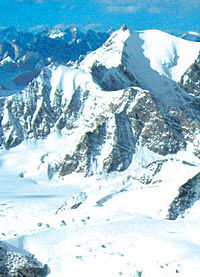Scandal rocks climate panel on glaciers

The Nobel Prize-winning organisation may take a decision on retracting its hugely controversial statement this week.
In its fourth assessment report released in 2007, IPCC claimed most of the Himalayan glaciers would vanish by 2035 because of global warming.
The claim was hugely contested in academic circles both in India and abroad in the last three months. Reports in the British media claimed that IPCC ignored the time-tested scientific touchstone of “peer review process” and relied on popular media reports to make its astounding claim.
With egg on its face, IPCC appears to be rethinking on the claim. “We are aware of the controversy. We are discussing it and will take a decision in the next 4-5 days,” IPCC chairman R K Pachauri told Deccan Herald on Sunday.
Pachauri, however, did not elaborate on whether the “decision” would mean retracting the controversial portion or standing by it.
Critics argue that the IPCC report was based on three documents – a 2005 report on glacier by the World Wide Fund for Nature, a 1996 UNESCO document and a New Scientist news report. None are peer reviewed.
The WWF report cited the New Scientist news in which a British journalist interviewed Indian glaciologist Syed Hasnain who made this claim. When the same journalist re-interviewed Hasnain in 2009, he admitted that it was only a speculation without any evidence.
After his retirement from Jawaharlal Nehru University here ,Hasnain is now associated with TERI as a senior fellow. Pachauri is the director general of TERI. Despite repeated attempts by Deccan Herald, Hasnain could not be reached.
IPCC claimed, “Glaciers in the Himalayas are receding faster than in any other part of the world and, if the present rate continues, the likelihood of them disappearing by the year 2035 and perhaps sooner is very high if the Earth keeps warming at the current rate.”
Scientists at the Ontario Trent University, Canada who helped unearth the misleading claims on Himalayan glaciers also charge the Intergovernmental Panel on Climate Change with another major blunder.
Time frame
A team led by J Graham Cogley quoted an earlier report by a Russian hydrographer that predicted substantial melting of the Himalayan glaciers by 2350.
The melting time frame was 300 years away..
The Intergovernmental Panel on Climate Change, Cogley claimed, made a blunder and may have published 2035 in place of 2350.
This incorrect depiction created confusion in the glaciologist community.
A section of Indian geologists headed by V K Raina, a former deputy director of the Geological Survey of India, too suggested Himalayan glaciers, had not in any way exhibited, especially in recent years, an abnormal annual retreat, of the order that some glaciers in Alaska and Greenland reported.
Had global warming be a real threat, such retreat in recent years was inevitable because the last decade was the warmest known to science.
Another explanations
True that Himalayan glaciers shrunk in volume and constantly showed a retreating front. But there may be other explanations.
Also most of the claims are based data from 20 Himalayan glaciers whereas there are 9500 glaciers in the Himalayas – the data simply is too inadequate.
Deccan Herald is on WhatsApp Channels| Join now for Breaking News & Editor's Picks